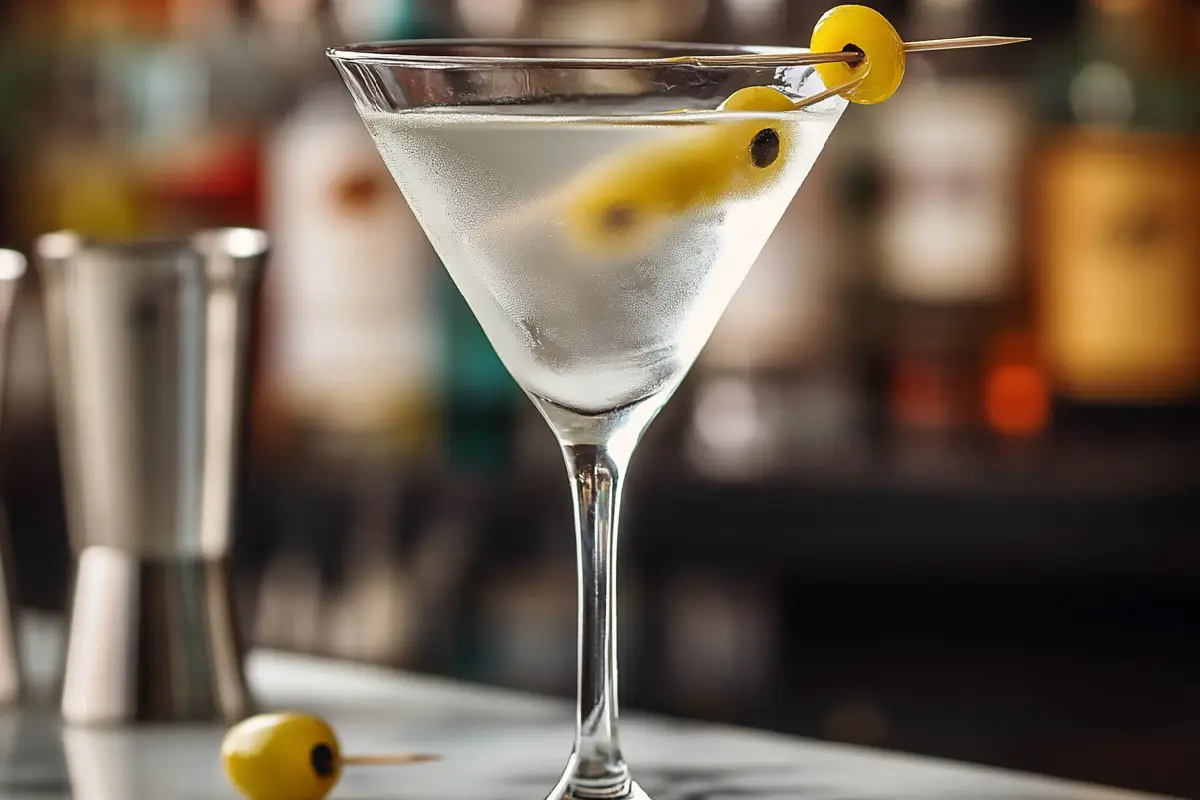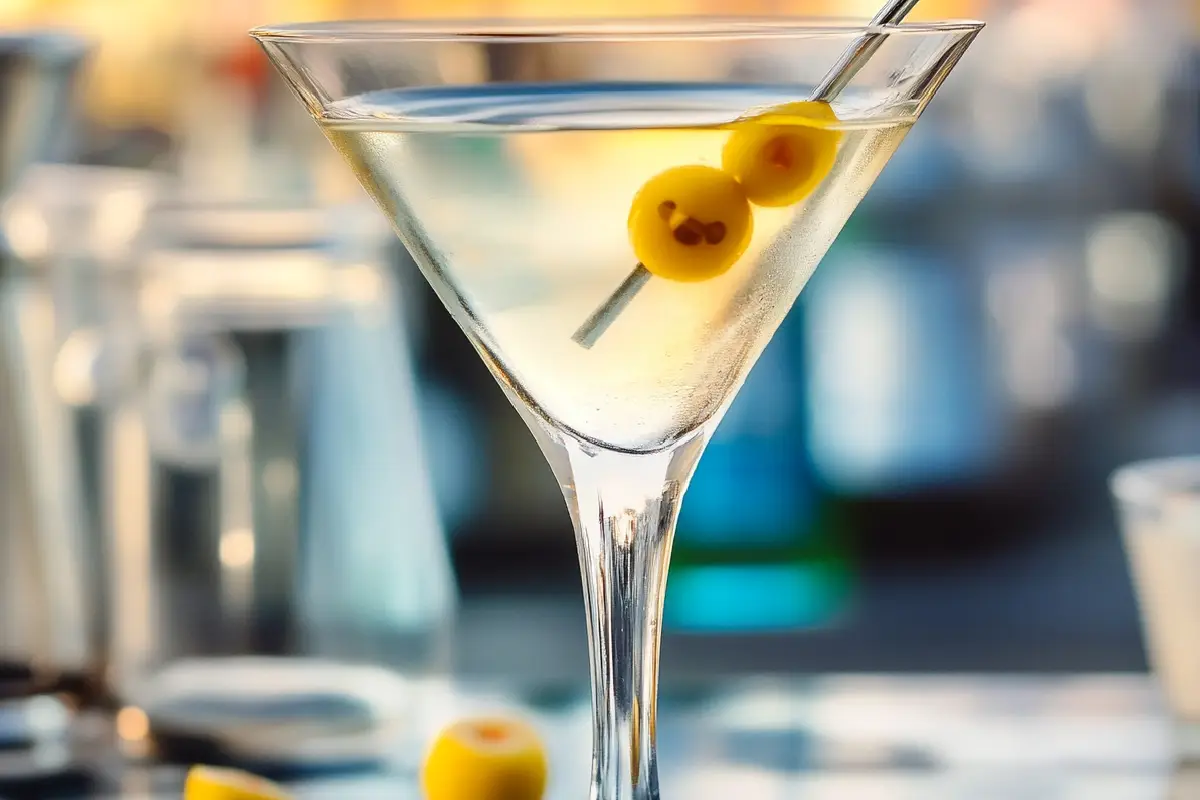Introduction to What’s in a Classic Martini
The martini is one of the most recognized and celebrated cocktails in the world. Known for its simplicity and elegance, the classic martini remains a favorite among cocktail enthusiasts. Whether it’s casually enjoyed at home or served at an upscale bar, the martini has maintained its legendary status. The drink has stood the test of time, often associated with sophistication, luxury, and a sense of occasion. Let’s see What’s in a Classic Martini?
At its core, the classic martini consists of a few key ingredients: gin or vodka, dry vermouth, and a garnish. However, small changes in the ratio or preparation can completely alter its taste and experience, making it a versatile drink with endless possibilities. But, as with any great cocktail, the devil is in the details.
The History of the Classic Martini
While its exact origin is often debated, the martini is thought to have evolved from a cocktail called the Martinez, dating back to the late 1800s. The Martinez was a mixture of Old Tom gin, vermouth, maraschino liqueur, and bitters, making it a close ancestor of the modern martini. Another popular theory claims the martini was first mixed during Prohibition, gaining popularity in New York and becoming a staple of American cocktail culture.
The martini reached the height of its popularity in the mid-20th century, particularly during the Mad Men era of the 1950s and 60s, when cocktails reigned supreme. Hollywood further cemented its reputation as the ultimate drink of choice for the sophisticated crowd, with iconic figures like James Bond famously ordering his Vesper Martini “shaken, not stirred.”
Even though the martini’s formula has remained relatively consistent over the years, its popularity surged during the 20th century, earning iconic status. Several variations have emerged, but the timeless combination of gin, vermouth, and a garnish remains at the heart of the classic recipe. Much like how the perfect martini balances ingredients, cocktails like the Cucumber Martini showcase how small changes can create entirely new experiences.
Ingredients: What’s in a Classic Martini?

Although the ingredient list is short, each component plays a crucial role in defining the character of a martini. Let’s break down each essential element:
1. Gin or Vodka
Traditionally, the martini is made with gin, which imparts a complex, botanical flavor. The mix of herbs, juniper berries, and spices in gin makes for a more aromatic drink, and it’s a big reason why gin martinis have such depth of flavor. London Dry gin, a popular choice, is known for its crisp, sharp, and slightly dry taste, making it perfect for a martini.
However, vodka is also a popular base for martinis, particularly since the 1980s. The neutral flavor of vodka allows for a smoother, more straightforward martini. A vodka martini can be an excellent choice for those who prefer a cleaner, more subdued cocktail.
2. Vermouth
Vermouth is a fortified wine infused with herbs, botanicals, and spices, and it’s an essential part of any martini. For a dry martini, dry vermouth (also known as French vermouth) is the typical choice. The amount of vermouth used can be adjusted according to taste, with some opting for just a splash or even none at all. A wet martini uses more vermouth, resulting in a lighter, smoother drink.
While dry vermouth is the go-to in most martinis, some variations, like the perfect martini, use equal parts dry and sweet vermouth, which results in a more complex and slightly sweeter flavor.
3. Garnish
The garnish is where personal preference really comes into play. The classic martini garnishes include either an olive or a lemon twist. The olive provides a briny, savory flavor that complements the dryness of the cocktail, while the lemon twist adds a zesty, citrusy note, brightening up the drink.
Some bartenders also use a cocktail onion to make a Gibson Martini. Each garnish changes the flavor profile of the martini in subtle yet distinct ways, and choosing the right one is key to personalizing your martini experience.
Different Styles of What is in a Classic Martini?
Depending on how much vermouth is added or what type of garnish is used, several styles of martinis have emerged. Here are some popular variations:
- Dry Martini: A dry martini features a small amount of vermouth, resulting in a stronger, more intense gin or vodka flavor.
- Wet Martini: This style has a higher proportion of vermouth, softening the alcoholic bite of the spirit.
- Dirty Martini: In this version, a splash of olive brine is added to the drink, giving it a saltier flavor. The olive brine lends a tangy and salty edge that enhances the natural dryness of the drink.
- Perfect Martini: A balanced combination of dry and sweet vermouth, offering a more complex, richer taste.
- Vodka Martini: Vodka replaces gin for a smoother and cleaner finish. This version has grown in popularity, especially among those who find gin’s botanicals too overpowering.
- Vesper Martini: Made famous by James Bond, this martini mixes gin, vodka, and Lillet Blanc for a more intricate flavor. The Vesper is often ordered “shaken, not stirred,” which is a famous departure from the typical martini preparation.
Beyond the Classics: Modern Martini Variations
The versatility of the martini means that bartenders and cocktail enthusiasts alike continue to experiment with new flavors and techniques. Some modern twists include the Espresso Martini, a delicious combination of vodka, coffee liqueur, and espresso, perfect for coffee lovers. There’s also the Apple Martini (or Appletini), which adds a sweet and tangy apple flavor to the classic cocktail, offering a fruity twist on the original.
Martini variations also extend to incorporating unique garnishes, infusions, and flavored vermouths. This freedom to experiment with ingredients has kept the martini evolving while still holding onto its classic roots.
Mixing Techniques and Tools for What is in a Classic Martini?
To make a martini that stands out, mastering the mixing technique is key. The martini may seem simple, but the right tools and techniques ensure you get a consistently good drink every time. Here are a few tips:
1. Shaken vs. Stirred
One of the most famous martini debates centers around whether the drink should be shaken or stirred. Shaking a martini chills and dilutes it more, giving it a frothier texture. Stirring, on the other hand, results in a smoother, silkier finish that many purists prefer.
2. Glassware
The iconic martini glass not only adds to the drink’s presentation but keeps the liquid cool without warming up from your hands. The long stem and wide rim give the martini its characteristic elegance. Always serve martinis in a well-chilled glass for the ultimate experience.
3. Chilling the Glass
Before preparing your martini, always chill the glass. It keeps the drink at the optimal temperature, ensuring the flavors come through bright and refreshing. Chilling the glass in the freezer for a few minutes before serving is the easiest method.
4. Ice and Dilution
While shaking or stirring your martini with ice, be mindful of dilution. The ice helps chill the martini, but too much agitation will over-dilute the drink, making it watery. Aim for a balance where the drink is perfectly chilled without losing too much of its strength.
How to Make a Classic Martini
Here’s a step-by-step guide to making your own classic martini:
Ingredients:
- 2 oz gin or vodka
- 1 oz dry vermouth
- Ice
- Olive or lemon twist for garnish
Directions:
- Fill a mixing glass with ice.
- Add the gin (or vodka) and vermouth.
- Stir for about 30 seconds or shake if preferred.
- Strain into a chilled martini glass.
- Garnish with an olive or lemon twist.
Tips:
- Adjust the gin-to-vermouth ratio to suit your taste.
- Experiment with different garnishes to see what complements your drink best.
Common Mistakes to Avoid in What is in a Classic Martini?
To craft the perfect martini, be mindful of these common mistakes:
- Over-shaking or under-stirring: Shaking too much dilutes the drink, while under-stirring leaves the martini too strong.
- Wrong garnish choice: Don’t overpower the martini with too strong a garnish; stick with the classic olive or lemon twist for the best result.
- Incorrect ratio of gin to vermouth: Finding the right balance of these two ingredients is essential for the ideal martini.
Martini Pairings with What’s in a Classic Martini
The classic martini pairs well with a variety of foods, especially those that bring out its dry, crisp nature. Here are some ideal pairings:
- Oysters: Their briny flavor matches the dryness of the martini.
- Salty Snacks: Olives, nuts, or cheese-based snacks complement the drink’s flavor.
- Charcuterie: Cured meats and cheeses offer a rich contrast to the martini’s light, dry profile.
- Crab Brûlée: For a more luxurious option, consider pairing your martini with Crab Brûlée, which provides a creamy, rich flavor to balance the sharpness of the cocktail.
FAQs about What’s in a Classic Martini

Is martini better with gin or vodka?
Both gin and vodka have their merits. Gin brings a botanical complexity, while vodka offers a smoother, more neutral flavor.
What vermouth should I use in a classic martini?
Dry vermouth is the traditional choice for a martini. Some variations, such as the perfect martini, call for a mix of dry and sweet vermouth.
Why is a martini garnished with an olive or lemon twist?
The garnish adds a subtle but essential flavor note. Olives contribute a briny, savory taste, while a lemon twist gives the drink a fresh, citrusy brightness.
What’s the difference between a dry and wet martini?
A dry martini has less vermouth, making it more spirit-forward, while a wet martini has more vermouth, offering a smoother sip.
What does “dirty martini” mean?
A dirty martini includes olive brine, which gives the drink a salty, savory flavor.
Conclusion: What’s in a Classic Martini?
The classic martini is a cocktail that, while simple in ingredients, offers endless possibilities in terms of customization and taste. Whether you prefer it dry, wet, dirty, or stirred, the martini’s timeless appeal lies in its versatility. By mastering the core ingredients and experimenting with ratios, you can find your perfect martini. Cheers!

